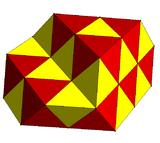Alternated hypercubic honeycomb
From Wikipedia, the free encyclopedia
 An alternated square tiling or checkerboard pattern. |
 An expanded square tiling. |
 A partially filled alternated cubic honeycomb with tetrahedral and octahedral cells. |
 A subsymmetry colored alternated cubic honeycomb. |
In geometry, the alternated hypercube honeycomb (or demicubic honeycomb) is a dimensional infinite series of honeycombs, based on the hypercube honeycomb with an alternation operation. It is given a Schläfli symbol h{4,3...3,4} representing the regular form with half the vertices removed and containing the symmetry of Coxeter group  for n ≥ 4. A lower symmetry form
for n ≥ 4. A lower symmetry form  can be created by removing another mirror on a order-4 peak.
can be created by removing another mirror on a order-4 peak.
The alternated hypercube facets become demihypercubes, and the deleted vertices create new orthoplex facets. The vertex figure for honeycombs of this family are rectified orthoplexes.
These are also named as hδn for an (n-1)-dimensional honeycomb.
| hδn | Name | Schläfli symbol |
Symmetry family | ||
|---|---|---|---|---|---|
 [4,3n-4,31,1] |
 [31,1,3n-5,31,1] | ||||
| Coxeter-Dynkin diagrams by family | |||||
| hδ2 | Apeirogon | {∞} | |||
| hδ3 | Alternated square tiling (Same as {4,4}) |
h{4,4}=t1{4,4} t0,2{4,4} |
|||
| hδ4 | Alternated cubic honeycomb | h{4,3,4} {31,1,4} |
|||
| hδ5 | 16-cell tetracomb (Same as {3,3,4,3}) |
h{4,32,4} {31,1,3,4} {31,1,1,1} |
|||
| hδ6 | 5-demicube honeycomb | h{4,33,4} {31,1,32,4} {31,1,3,31,1} |
|||
| hδ7 | 6-demicube honeycomb | h{4,34,4} {31,1,33,4} {31,1,32,31,1} |
|||
| hδ8 | 7-demicube honeycomb | h{4,35,4} {31,1,34,4} {31,1,33,31,1} |
|||
| hδ9 | 8-demicube honeycomb | h{4,36,4} {31,1,35,4} {31,1,34,31,1} |
|||
| hδn | n-demicubic honeycomb | h{4,3n-3,4} {31,1,3n-4,4} {31,1,3n-5,31,1} |
... | ||
References
- Coxeter, H.S.M. Regular Polytopes, (3rd edition, 1973), Dover edition, ISBN 0-486-61480-8
- pp. 122-123, 1973. (The lattice of hypercubes γn form the cubic honeycombs, δn+1)
- pp. 154-156: Partial truncation or alternation, represented by h prefix: h{4,4}={4,4}; h{4,3,4}={31,1,4}, h{4,3,3,4}={3,3,4,3}
- p. 296, Table II: Regular honeycombs, δn+1
| Fundamental convex regular and uniform honeycombs in dimensions 2–11 | |||||
|---|---|---|---|---|---|
| Family |  |
 |
 |
 |
 / /  / /  |
| Uniform tiling | {3[3]} | δ3 | hδ3 | qδ3 | Hexagonal |
| Uniform convex honeycomb | {3[4]} | δ4 | hδ4 | qδ4 | |
| Uniform 5-honeycomb | {3[5]} | δ5 | hδ5 | qδ5 | 24-cell honeycomb |
| Uniform 6-honeycomb | {3[6]} | δ6 | hδ6 | qδ6 | |
| Uniform 7-honeycomb | {3[7]} | δ7 | hδ7 | qδ7 | 222 |
| Uniform 8-honeycomb | {3[8]} | δ8 | hδ8 | qδ8 | 133 • 331 |
| Uniform 9-honeycomb | {3[9]} | δ9 | hδ9 | qδ9 | 152 • 251 • 521 |
| Uniform n-honeycomb | {3[n]} | δn | hδn | qδn | 1k2 • 2k1 • k21 |
This article is issued from Wikipedia. The text is available under the Creative Commons Attribution/Share Alike; additional terms may apply for the media files.